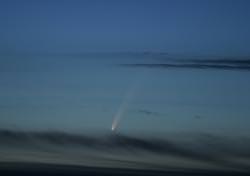 Bad Astronomer Phil Plait is raving about it, our forum is buzzing about it, and there seem to be stories and photographs and popping up everywhere. One of the brightest comets we’ve seen in decades is blazing across the night sky, but you’ve got to move fast if you want to see it.
Bad Astronomer Phil Plait is raving about it, our forum is buzzing about it, and there seem to be stories and photographs and popping up everywhere. One of the brightest comets we’ve seen in decades is blazing across the night sky, but you’ve got to move fast if you want to see it.
Continue reading “See the Brightest Comet in 30 Years”
A New Target for Deep Impact
NASA announced today that it will be extending Deep Impact’s mission, giving it a chance to visit another comet. The mission made big news when it slammed an impactor spacecraft into Comet Tempel 1 in July, 2005. NASA had hoped they could steer the spacecraft past another comet, to continue its scientific discoveries. Mission planners chose Comet Boethin as the spacecraft’s next target, which it should be able to reach in December, 2008.
Continue reading “A New Target for Deep Impact”
Help Look for Space Dust
If you’ve got keen eyes, a computer connection, and a little spare time, you could help discover particles of interstellar dust. Poring over the samples returned by NASA’s Stardust probe is a big job, so the scientists have opened up the task to volunteers through the Internet. Using a virtual microscope, volunteers can download images and search for the telltale track of a interstellar dust particles that were captured in aerogel. Discoverers will get a chance to name the particles they discover.
Continue reading “Help Look for Space Dust”
Spitzer View of Comet Chunks
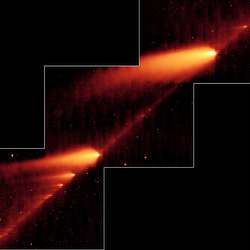
The broken Comet 73P/Schwassman-Wachmann 3. Image credit: NASA/JPL-Caltech. Click to enlarge
As Comet 73P/Schwassman-Wachmann 3 is falling apart before our eyes, astronomers from around the world have been recording and studying the process. This recent photograph, released from the Spitzer Space Telescope, shows 45 of the comet’s 58 known fragments. The infrared telescope also has a great view of the cooler dust particles that fill in the trail between the comet chunks.
NASA’s Spitzer Space Telescope has snapped a picture of the bits and pieces making up Comet 73P/Schwassman-Wachmann 3, which is continuing to break apart on its periodic journey around the sun. The new infrared view shows several chunks of the comet riding along its own dusty trail of crumbs.
“Spitzer has revealed a trail of meteor-sized debris filling the comet’s orbit,” said Dr. William T. Reach of NASA’s Spitzer Science Center at the California Institute of Technology, Pasadena. Reach and his team recently observed the comet using Spitzer.
Comet 73P/Schwassman-Wachmann 3 consists of a collection of fragments that file along like ducks in a row around the sun every 5.4 years. This year, the bunch will pass by Earth beginning on May 12 before swinging by the sun on June 6. The fragments won’t get too close to Earth, about 7.3 million miles, or 30 times the distance between Earth and the moon, but they should be visible through binoculars in the countryside night skies.
The icy comet began falling apart in 1995 during one of its tropical trips to the sun. Astronomers believe that its crusty outer layer cracked due to the heat, allowing fresh ice to evaporate and split the comet apart.
During the past six weeks, amateur and professional astronomers have been watching the comet fall apart before their telescopes’ eyes. Spitzer viewed the broken comet from its quiet perch up in space May 4 to May 6, covering a portion of the sky that allowed it to spot 45 of the 58 known fragments.
The observatory’s infrared view also provides the first look at the dusty trail left by the disintegrating comet after it splintered apart in 1995. The trail is made up of comet dust, pebbles and rocks that occasionally rain down on Earth in what is called the Tau Herculid meteor shower. From May 19 to June 19, as Earth passes through the outskirts of the trail, only a weak meteor shower is expected, with just a few “shooting stars” visible in the night sky. A larger meteor shower might occur in 2022 if Earth crosses near the comet’s wake as predicted.
Spitzer’s infrared eyes were able to see the dusty comet bits lining the trail because the dust is warmed by sunlight and glows at infrared wavelengths. Most of the dust particles, specifically the millimeter-sized nuggets, had never been seen before. Reach said that these particles probably represent the natural deterioration of the comet over the years, a process commonly observed in intact comets.
The comet dust also adds up to more evidence for the “icy dirtball” theory of comets. In recent years, more and more astronomers are coming to think of comets not as snowballs coated in dust, but as dirtballs crusted with ice.
“By measuring the brightness and extent of the debris trail, we are trying to find out whether most of the comet’s mass disintegrates into vapors from evaporating ice, the house-sized chunks seen in images from the Hubble Space Telescope, or the meteor-sized debris seen in the Spitzer images,” said Reach.
Reach and his team will continue to study the Spitzer data for clues to how the comet broke up. Their infrared data will tell them the sizes of the major fragments, which might indicate whether the comet did, as believed, crack under the thermal stress.
Comet 73P/Schwassman-Wachmann 3 should be dimly visible through binoculars on a clear night between the Cygnus and Pegasus constellations from May 12 to May 28. For more information about viewing the comet or the meteors, visit http://science.nasa.gov/headlines/y2006/24mar_73p.htm. None of the comet’s fragments pose a danger to Earth. For more information, see http://www.nasa.gov/mission_pages/hubble/Comet_73P.html.
Members of Reach’s team include: Dr. Michael Kelley of the University of Minnesota, Twin Cities; Dr. Carey M. Lisse of the Johns Hopkins University’s Applied Physics Laboratory, Laurel, Md.; Dr. Mark Sykes of Planetary Science Institute, Tucson, Ariz.; and Dr. Masateru Ishiguro of the Institute of Space and Astronautical Science, Japan.
NASA’s Jet Propulsion Laboratory, Pasadena, Calif., manages the Spitzer Space Telescope mission for NASA’s Science Mission Directorate, Washington. Science operations are conducted at the Spitzer Science Center at the California Institute of Technology. Spitzer’s multi-band imaging photometer, which made the observations, was built by Ball Aerospace Corporation, Boulder, Colo.; the University of Arizona, Tucson; and Boeing North American, Canoga Park, Calif. The instrument’s principal investigator is Dr. George Rieke of the University of Arizona.
Original Source: NASA Spitzer Telescope
Comets May Be the Source of Earth’s Water
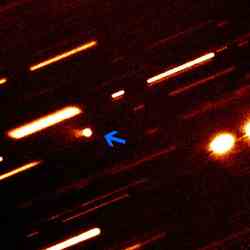
The new comet is indicated by the blue arrow. Image credit: Gemini Observatory Click to enlarge
Astronomers have discovered three icy comets that may help explain how the Earth’s oceans formed. These new comets have asteroid-like orbits, and formed in the warm inner Solar System, not in the outer reaches like most comets. This lends evidence to the theory that the main asteroid belt isn’t bone dry, as previously believed, but is actually quite rich in ice – a major source of our planet’s water.
Three icy comets orbiting among the rocky asteroids in the main asteroid belt between Mars and Jupiter may hold clues to the origin of Earth’s oceans.
The newly discovered group of comets, dubbed “main-belt comets” by University of Hawaii graduate student Henry Hsieh and Professor David Jewitt, has asteroid-like orbits and, unlike other comets, appears to have formed in the warm inner solar system inside the orbit of Jupiter rather than in the cold outer solar system beyond Neptune.
The existence of these main-belt comets suggests that asteroids and comets are much more closely related than previously thought and supports the idea that icy objects from the main asteroid belt could be a major source of Earth’s present-day water. This work appears in the March 23 edition of Science Express (pdf) and will also appear in an April print edition of Science.
The crucial observations were made on November 26, 2005, using the 8-meter Gemini North Telescope on Mauna Kea. Hsieh and Jewitt found that an object designated as Asteroid 118401 was ejecting dust like a comet. Together with a mysterious comet (designated 133P/Elst-Pizarro) known for almost a decade but still poorly understood, and another comet (designated P/2005 U1) discovered by the Spacewatch project in Arizona just a month earlier, “Asteroid” 118401 forms an entirely new class of comets.
“The main-belt comets are unique in that they have flat, circular, asteroid-like orbits, and not the elongated, often tilted orbits characteristic of all other comets,” said Hsieh. “At the same time, their cometary appearance makes them unlike all other previously observed asteroids. They do not fit neatly in either category.”
In both 1996 and 2002, the “original” main-belt comet, 133P/Elst-Pizarro (named after its two discoverers), was seen to exhibit a long dust tail typical of icy comets, despite having the flat, circular orbit typical of presumably dry, rocky asteroids. As the only main-belt object ever observed to take on a cometary appearance, however, 133P/Elst-Pizarro’s true nature remained controversial. Until now.
“The discovery of the other main-belt comets shows that 133P/Elst-Pizarro is not alone in the asteroid belt,” Jewitt said. “Therefore, it is probably an ordinary (although icy) asteroid, and not a comet from the outer solar system that has somehow had its comet-like orbit transformed into an asteroid-like one. This means that other asteroids could have ice as well.”
The Earth is believed to have formed hot and dry, meaning that its current water content must have been delivered after the planet cooled. Possible candidates for supplying this water are colliding comets and asteroids. Because of their large ice content, comets were leading candidates for many years, but recent analysis of comet water has shown that comet water is significantly different from typical ocean water on Earth.
Asteroidal ice may give a better match to Earth’s water, but until now, any ice that the asteroids may have once contained was thought to either be long gone or so deeply buried inside large asteroids as to be inaccessible for further analysis. The discovery of main-belt comets means that this ice is not gone and is still accessible (right on the surfaces of at least some objects in the main belt, and at times, even venting into space). Spacecraft missions to the main-belt comets could provide new, more detailed information on their ice content and in turn give us new insight into the origin of the water, and ultimately life, on Earth.
As conventionally defined, comets and asteroids are very different. Both are objects a few to a few hundred miles across that orbit throughout our solar system. Comets, however, are thought to originate in the cold outer solar system and consequently contain much more ice than the asteroids, most of which are thought to have formed much closer to the Sun in the asteroid belt between Mars and Jupiter.
Comets also have large, elongated orbits and thus experience wide temperature variations. When a comet approaches the Sun, its ice heats up and sublimates (changes directly from ice to gas), venting gas and dust into space, giving rise to a tail and a distinctive fuzzy appearance. Far from the Sun, sublimation stops, and any remaining ice stays frozen until the comet’s next pass close to the Sun. In contrast, objects in the asteroid belt have essentially circular orbits and are expected to be mostly baked dry of ice by their confinement to the inner solar system. Essentially, they should be just rocks. With the discovery of the main-belt comets, we now know this is not the case, and that, in general, the conventional definitions of comets and asteroids are in need of refinement.
This work is supported by a grant from the NASA Planetary Astronomy Program of the Science Mission Directorate.
More information: http://www.ifa.hawaii.edu/~hsieh/mbcs.html
Original Source: University of Hawaii
Giotto Met Halley 20 Years Ago
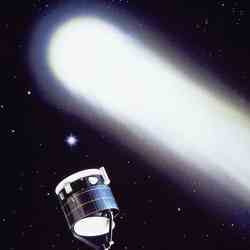
An artist’s impression of Giotto’s brief encounter with comet Halley. Image credit: ESA Click to enlarge
This week the European Space Agency celebrated the 20-year anniversary of the Giotto spacecraft’s encounter with Comet Halley. This was ESA’s first deep space mission, which launched on board an Ariane 1 rocket. Giotto flew for 8 months, traveling almost 150 million kilometres. It swept past the comet on March 13, 1986, getting as close as 596 km (370 miles), and delivered the best pictures ever seen of a comet’s nucleus.
Twenty years ago, in the night between 13 and 14 March 1986, ESA’s Giotto spacecraft encountered Comet Halley. It was ESA’s first deep space mission, and part of an ambitious international effort to solve the riddles surrounding this mysterious object.
The adventure began when Giotto was launched by an Ariane 1 rocket (flight V14) on 2 July 1985. After three revolutions around the Earth, the on-board motor was fired to inject it into an interplanetary orbit.
After a cruise of eight months and almost 150 million kilometres, the spacecraft’s instruments first detected hydrogen ions from Halley at a distance of 7.8 million kilometres from the comet on 12 March 1986.
Giotto encountered Comet Halley about one day later, when it crossed the bow shock of the solar wind (the region where a shock wave is created as the supersonic solar particles slow to subsonic speed). When Giotto entered the densest part of the dusty coma, the camera began tracking the brightest object (the nucleus) in its field of view.
Excitement rose at the European Space Operations Centre in Darmstadt, Germany, as the first fuzzy images and data came in. The ten experiment teams scrutinised the latest information and struggled to come up with a preliminary analysis.
The first of 12 000 dust impacts was recorded 122 minutes before closest approach. Images were transmitted as Giotto closed in to within a distance of approximately 2000 kilometres, as the rate of dust impacts rose sharply and the spacecraft passed through a jet of material that streamed away from the nucleus.
The spacecraft was travelling at a speed of 68 kilometres per second relative to the comet. At 7.6 seconds before closest approach, the spacecraft was sent spinning by an impact from a ‘large’ (one gram) particle. Monitor screens went blank as contact with Earth was temporarily lost.
TV audiences and anxious Giotto team members feared the worst but, to everyone’s amazement, occasional bursts of information began to come through. Giotto was still alive.
Over the next 32 minutes, the sturdy spacecraft’s thrusters stabilised its motion and contact was fully restored. By then, Giotto had passed within 596 kilometres of the nucleus and was heading back into interplanetary space.
The remarkably resilient little spacecraft continued to return scientific data for another 24 hours on the outward journey. The last dust impact was detected 49 minutes after closest approach. The historic encounter ended 15 March when Giotto’s experiments were turned off.
Original Source: ESA Portal
The Risk of a Comet Strike is Low
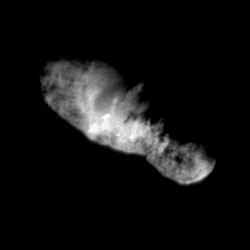
Comet. Image credit: NASA/JPL Click to enlarge
The chances of the Earth being hit by a comet from beyond Pluto ? ? la Deep Impact ? are much lower than previously thought, according to new research by an ANU astronomer.
Using computer simulations and data from an American military telescope, Dr Paul Francis, from the ANU Research School of Astronomy and Astrophysics at Mt Stromlo, has found there are seven times fewer comets in our solar system than previously thought.
?I calculate that small comets, capable of destroying a city, only hit the Earth once every 40 million years or so,? Dr Francis said. ?Big continent-busting comets, as shown in the movie Deep Impact, are rarer still, only hitting once every 150 million years or so. So I don?t lose sleep over it, but you?re still more likely to be killed by a comet than to win the Lotto jackpot.?
Previous estimates of the number of comets were based on the work of amateur astronomers, who for hundreds of years have been scanning the skies, looking for new comets.
Previously, it was believed that these amateur astronomers were only spotting three per cent of the comets passing close to the Earth: the rest were thought to be missed because they were in the wrong part of the sky or were too faint.
But Dr Francis found that the amateurs were doing better than anyone had realised ? they were actually spotting 20 per cent of comets. There are therefore far fewer undiscovered comets.
?The new data allowed us to count the number of faint and far-away comets that the amateurs had missed. And we found that they were pretty rare,? Dr Francis said.
These results apply to comets coming from beyond the orbit of Pluto, which is where most comets live. The Earth is still at risk of being hit by asteroids, and by so-called short-period comets ? ones that come past repeatedly, like Halley?s comet.
?But asteroids and short-period comets come past again and again, so if we?re clever enough we can find them all and predict which, if any, will hit the Earth,? said Dr Francis. ?If we find one on a collision course with the Earth, we would normally have hundreds of years warning in which to do something about it, like deflecting the asteroid.
?The comets coming from beyond Pluto, so called long-period comets, are nastier, as they are totally unpredictable, and if we see one on a collision course we?d have at best one or two years warning ? not long enough to do anything.?
Dr Francis? research has been accepted for publication in the Astrophysical Journal. It was based on computer simulations, published data from the Lincoln Near Earth Asteroid Research Project at White Sands Missile Range in New Mexico, and on data from amateur astronomers around the world.
Original Source: ANU News Release
Tempel 1’s Ingredients
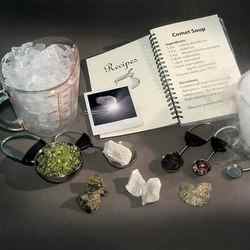
Astronomers using data from Spitzer and Deep Impact are preparing a comet “soup”. Image credit: NASA Click to enlarge
When Deep Impact smashed into comet Tempel 1 on July 4, 2005, it released the ingredients of our solar system’s primordial “soup.” Now, astronomers using data from NASA’s Spitzer Space Telescope and Deep Impact have analyzed that soup and begun to come up with a recipe for what makes planets, comets and other bodies in our solar system.
“The Deep Impact experiment worked,” said Dr. Carey Lisse of Johns Hopkins University’s Applied Physics Laboratory, Laurel, Md. “We are assembling a list of comet ingredients that will be used by other scientists for years to come.” Lisse is the team leader for Spitzer’s observations of Tempel 1. He presented his findings this week at the 37th annual meeting of the Division of Planetary Sciences in Cambridge, England.
Spitzer watched the Deep Impact encounter from its lofty perch in space. It trained its infrared spectrograph on comet Tempel 1, observing closely the cloud of material that was ejected when Deep Impact’s probe plunged below the comet?s surface. Astronomers are still studying the Spitzer data, but so far they have spotted the signatures of a handful of ingredients, essentially the meat of comet soup.
These solid ingredients include many standard comet components, such as silicates, or sand. And like any good recipe, there are also surprise ingredients, such as clay and chemicals in seashells called carbonates. These compounds were unexpected because they are thought to require liquid water to form.
“How did clay and carbonates form in frozen comets?” asked Lisse. “We don’t know, but their presence may imply that the primordial solar system was thoroughly mixed together, allowing material formed near the Sun where water is liquid, and frozen material from out by Uranus and Neptune, to be included in the same body.”
Also found were chemicals never seen before in comets, such as iron-bearing compounds and aromatic hydrocarbons, found in barbecue pits and automobile exhaust on Earth.
The silicates spotted by Spitzer are crystallized grains even smaller than sand, like crushed gems. One of these silicates is a mineral called olivine, found on the glimmering shores of Hawaii’s Green Sands Beach.
Planets, comets and asteroids were all born out of a thick soup of chemicals that surrounded our young Sun about 4.5 billion years ago. Because comets formed in the outer, chilly regions of our solar system, some of this early planetary material is still frozen inside them.
Having this new grocery list of comet ingredients means theoreticians can begin testing their models of planet formation. By plugging the chemicals into their formulas, they can assess what kinds of planets come out the other end.
“Now, we can stop guessing at what’s inside comets,” said Dr. Mike A’Hearn, principal investigator for the Deep Impact mission, University of Maryland, College Park. “This information is invaluable for piecing together how our own planets as well as other distant worlds may have formed.”
NASA’s Jet Propulsion Laboratory, Pasadena, Calif., manages the Spitzer Space Telescope mission for NASA’s Science Mission Directorate, Washington. Science operations are conducted at the Spitzer Science Center at Caltech. The University of Maryland, College Park, conducted the overall mission management for Deep Impact, and JPL handled project management for the mission for NASA’s Science Mission Directorate.
For more graphics and more information about Spitzer, visit http://www.spitzer.caltech.edu/Media/index.shtml .
Original source: NASA News Release
Surprising Insights Into Comet Tempel 1
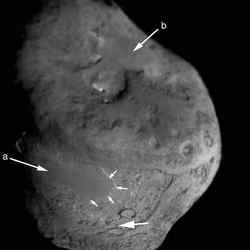
Comet Tempel 1. Image credit: NASA/JPL Click to enlarge
Painting by the numbers is a good description of how scientists create pictures of everything from atoms in our bodies to asteroids and comets in our solar system. Researchers involved in NASA’s Deep Impact mission have been doing this kind of work since the mission’s July 4th collision with comet Tempel 1.
“Prior to our Deep Impact experiment, scientists had a lot of questions and untested ideas about the structure and composition of the nucleus, or solid body of a comet, but we had almost no real knowledge,” said Deep Impact principal investigator Dr. Michael A’Hearn, a professor of astronomy at the University of Maryland, College Park. “Our analysis of data produced by Deep Impact is revealing a great deal, much of it rather surprising.”
For example, comet Tempel 1 has a very fluffy structure that is weaker than a bank of powder snow. The fine dust of the comet is held together by gravity. However, that gravity is so weak, if you could stand on the bank and jump, you would launch yourself into space.
Another surprise for A’Hearn and his colleagues was the evidence of what appears to be impact craters on the surface of the comet. Previously, two other comets had their nuclei closely observed and neither showed evidence of impact craters.
“The nucleus of Tempel 1 has distinct layers shown in topographic relief ranging from very smooth areas to areas with features that satisfy all the criteria for impact craters, including varying size,” A’Hearn said. “The problem in stating with certainty that these are impact craters is that we don’t know of a mechanism by which some comets would collide with the flotsam and jetsam in our solar system, while others would not.?
According to A’Hearn, one of the more interesting findings may be the huge increase in carbon-containing molecules detected in spectral analysis of the ejection plume. This finding indicates comets contain a substantial amount of organic material, so they could have brought such material to Earth early in the planet’s history when strikes by asteroids and meteors were common.
Another finding is the comet interior is well shielded from the solar heating experienced by the surface of the comet nucleus. Mission data indicate the nucleus of Tempel 1 is extremely porous. Its porosity allows the surface of the nucleus to heat up and cool down almost instantly in response to sunlight. This suggests heat is not easily conducted to the interior and the ice and other material deep inside the nucleus may be pristine and unchanged from the early days of the solar system, just as many scientists had suggested.
“The infrared spectrometer gave us the first temperature map of a comet, allowing us to measure the surface’s thermal inertia, or ability to conduct heat to the interior,” said Dr. Olivier Groussin, the University of Maryland research scientist who generated the map.
It is this diligent and time consuming analysis of spectral data that is providing much of the “color” with which Deep Impact scientists are painting the first ever detailed picture of a comet. For example, researchers recently saw emission bands for water vaporized by the heat of the impact, followed a few seconds later by absorption bands from ice particles ejected from below the surface and not melted or vaporized.
“In a couple of seconds the fast, hot moving plume containing water vapor left the view of the spectrometer, and we are suddenly seeing the excavation of sub-surface ice and dust,” said Deep Impact co-investigator Dr. Jessica Sunshine, with Science Applications International Corporation, Chantilly, Va. “It is the most dramatic spectral change I’ve ever seen.”
These findings are published in the September 9 issue of the journal Science, and were presented this week at the Division for Planetary Sciences meeting in Cambridge, England. Mission scientists are filling in important new portions of a cometary picture that is still far from finished.
The University of Maryland is responsible for overall Deep Impact mission science, and project management is handled by JPL. The spacecraft was built for NASA by Ball Aerospace & Technologies Corporation, Boulder, Colo. JPL is a division of the California Institute of Technology, Pasadena, Calif.
For more information about the Deep Impact mission on the Internet, visit: http://www.nasa.gov/deepimpact .
original Source: NASA News Release
SOHO Gets Its 1,000th Comet
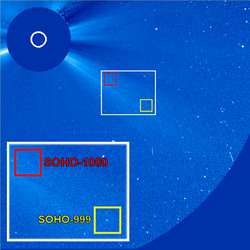
999th and 1000th comets identified in SOHO images. Image credit: ESA/NASA Click to enlarge
On 5 August 2005, the ESA/NASA SOHO spacecraft achieved an incredible milestone – the discovery of its 1000th comet!
The 1000th comet was a Kreutz-group comet spotted in images from the C3 coronagraph on SOHO’s LASCO instrument by Toni Scarmato, from Calabria, Italy.
Just five minutes prior to discovering SOHO’s 1000th comet, Toni had also spotted SOHO’s 999th comet! These comets take Toni’s personal number of SOHO discoveries to 15.
Many SOHO comet discoveries have been by amateurs using SOHO images on the internet, and SOHO comet hunters come from all over the world. Toni Scarmato, a high school teacher and astrophysics graduate of the University of Bologna, said: ?I am very happy for this special experience that is possible thanks to the SOHO satellite and NASA-ESA collaboration.
“I want to dedicate the SOHO 1000th comet to my wife Rosy and my son Kevin to compensate for the time that I have taken from them to search for SOHO comets.”
The SOHO team also held a contest over the internet to guess the time when the 1000th comet would be discovered. The contest winner is Andrew Dolgopolov of Dublin, Ireland, who guessed the time of the comet?s closest approach to the Sun (perihelion time) within 22 minutes.
SOHO, the Solar and Heliospheric Observatory , is a joint effort between NASA and ESA and is now in its tenth year of operation. Although it was originally planned as a solar and heliospheric mission, it was optimistically hoped that LASCO might observe at least a handful of ?sungrazer? comets, based on the success of the SOLWIND coronagraph in the late 1970s and 1980s, which discovered a small number of very bright Kreutz-group comets.
It was not long after SOHO began sending down a steady stream of data in 1996 that SOHO scientists spotted a Kreutz-group comet in LASCO images. Soon, several more comets had been found and word started to spread of SOHO?s potential as a comet discoverer.
In 2000, amateur astronomer Mike Oates started to search the SOHO images, which had recently became available via the internet. He soon revealed just how much potential SOHO had by quickly spotting over 100 comets in LASCO images.
Almost all SOHO’s comets are discovered using images from its LASCO instrument, the Large Angle and Spectrometric Coronagraph. LASCO is used to observe the faint, multimillion-degree outer atmosphere of the Sun, called the corona. A disk in the instrument is used to make an artificial eclipse, blocking direct light from the Sun so the much fainter corona can be seen. Sungrazing comets are discovered when they enter LASCO’s field of view as they pass close by the Sun.
As time passed, more professional astronomers, as well as amateur enthusiasts from all over the world, joined the search for SOHO comets. In August 2002, Rainer Kracht (now the leading SOHO comet discoverer, with over 150 SOHO comets) spotted SOHO?s 500th comet. This in itself was an achievement that none of the SOHO/LASCO scientists ever imagined would, or could, happen.
However, just three years later, SOHO, with 1000 comet discoveries, is responsible for almost half of all officially recorded comets in history! Add to this the fact that the SOHO mission has completely revolutionised solar physics and the understanding of the Sun, and it shows just how truly amazing the SOHO spacecraft is!
Original Source: ESA Portal
